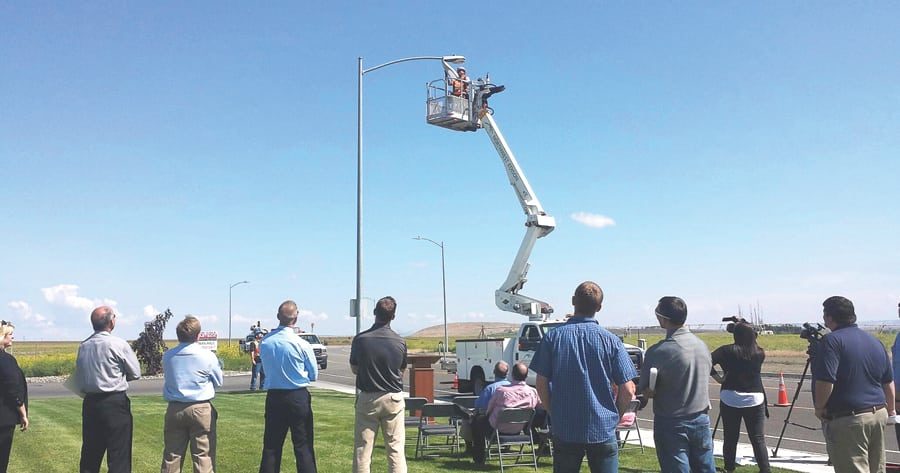
Home » Cities choose cost-effective lighting options to save money, energy
Cities choose cost-effective lighting options to save money, energy

August 16, 2016
Tri-City area governments are saving money after installing low-energy, long-lasting streetlights.
The city of West Richland was the first to implement an emission-reduction policy six years ago that would save energy as well as money, said Drew Woodruff, West Richland’s city engineer.
“The city had about 1,100 streetlights that were all high pressure sodium (HPS) bulbs and our annual lighting costs were $94,152 per year, which was more than 20 percent of our already minimal street operations and maintenance budget,” Woodruff said.
City officials and the Benton Rural Electric Association, which provides West Richland’s power, looked at both induction and LED lights as replacements and decided LED was a more progressive way to go.
“At the time we were having these meetings, many of the adjacent cities were converting to induction as LED was still very new, expensive and rapidly evolving,” Woodruff said. “The city did not feel that induction was the right direction to go as it was an older technology and the path forward appeared to be moving drastically to LED but it had to make sense financially. The city did not have the money to consider any sort of full city retrofit at that time and was just looking at changing our standards for all new lights moving forward.”
West Richland received rebates and incentives for close to $1 million from the Bonneville Power Administration, Benton REA and other state and federal grant programs to switch out 1,100 streetlights to energy-saving LEDs. The city’s cost for the project was about $151,000.
Its retrofit efforts earned a write up in a national public works publication last year.
And city officials in Pasco, Kennewick and Richland have since followed suit.
Pasco has replaced about half of its streetlights with energy-saving induction type fixtures, which are a type of fluorescent, and the other half with LEDs, also energy-saving, said Stan Strebel, assistant city manager.
Pasco began replacing the old high-pressure sodium type lamps with induction units, primarily in residential areas, in 2011, he said. The change-over for most of the streetlights was made possible with a Department of Energy grant that was part of the 2009 federal stimulus package.
“We worked with Franklin County PUD to secure a Washington Department of Commerce grant in 2014 to replace most of the remainder of our lights, primarily along major streets and commercial areas, with LED fixtures,” Strebel said.
Before the replacements were installed, the city had about 3,650 lights with an annual energy cost of $223,400, he said. Today, there are 4,100 lights around the city that incur an energy cost of about $146,000.
“We do not have a system where lights can be adjusted remotely,” he said. “Lights are controlled by photocell.”
Kennewick, Richland and West Richland have seen similar savings.
The city of Kennewick’s Energy Conservation Measure converted 5,672 high-pressure sodium streetlights to induction lights in 2012, which saw a 49 percent reduction in energy use, said Evelyn Lusignan, public relations manager for the city.
Induction lights are similar to fluorescent lamps but use a high frequency generator with a power coupler to excite the gas. The change brought a 50 percent savings in energy costs over the high-pressure sodium lights, Lusignan said.
The bulb life of induction lights, which is a whiter light, is about 100,000 hours versus 25,000 hours for high-pressure sodium lights. The city saves about $165,000 a year in energy and maintenance costs with the new lights.
Kennewick received a rebate of about $672,000 from the Benton PUD for its Energy Conservation Measure, Lusignan said.
The measure is part of the federal Energy Efficiency and Conservation Block Grant program funded by the American Recovery and Reinvestment Act. It provides grants for projects that reduce total energy use and fossil fuel emissions. Funding is based on a formula that accounts for population and energy use.
“We do not have the remote adjustment capability with the induction lighting,” she said. “The newer LED lighting has that capability, (but) when we were planning our replacement project, LED was more expensive and the BPA was more willing to give us a rebate with induction lighting.”
The city of Richland adopted an energy-saving streetlight program in 2015 that requires all new developments have LED streetlights.
“The city has approximately 4,700 streetlights,” said Jeff Peters, transportation and development manager for the city of Richland.
He said the city is working toward a replacement strategy for all city streetlights but currently only the new development areas have LED lights in use. Replacing all streetlights in the city will be done in 5- to 7-year phases, Peters added.
Pete Rogalsky, Richland’s public works director, said the new energy-saving lights haven’t been up long enough to determine what kind of savings the city will see in energy costs.
“The HPS streetlights (that burn hotter) have to be changed every couple of years,” Rogalsky said. “But the LEDs can go as long as a decade before they need to be replaced.”
Local News Environment
KEYWORDS august 2016





